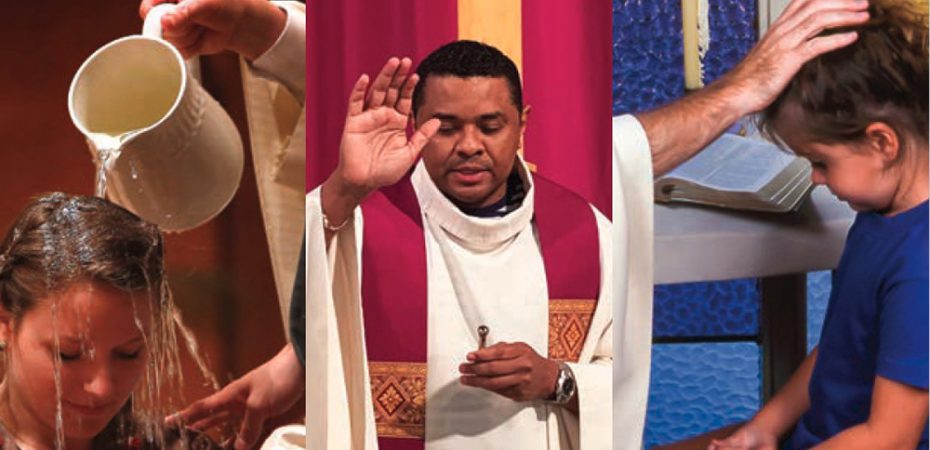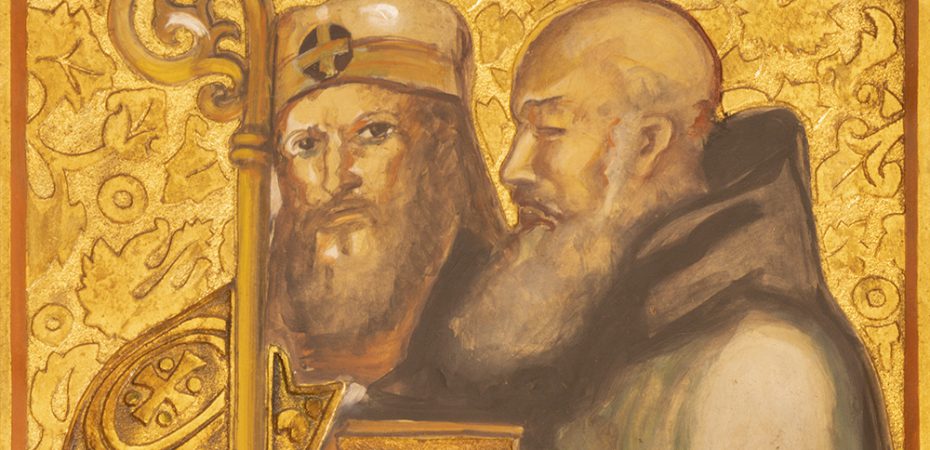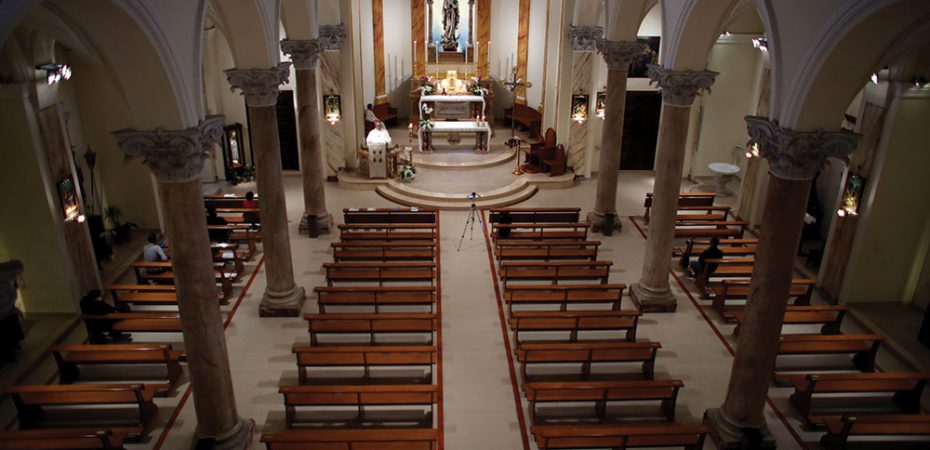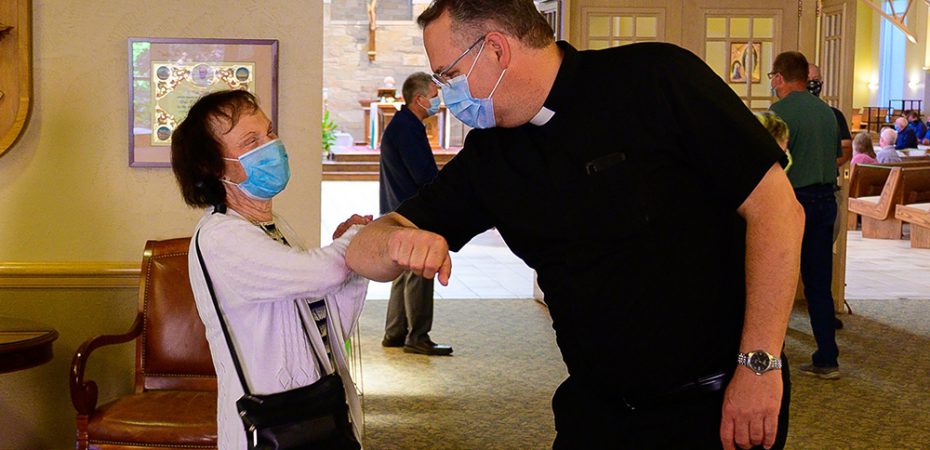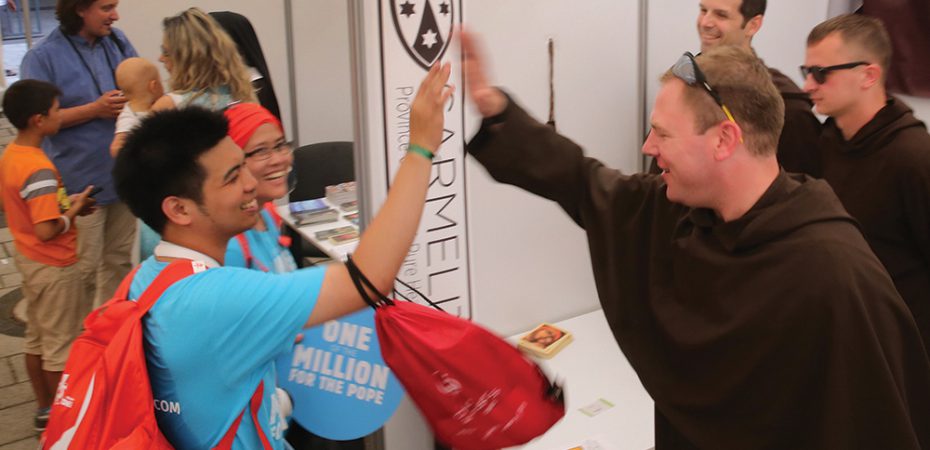The Beautiful Hands of a Priest
Understanding the gestures we use at Mass
Father Alexander Masluk Comments Off on The Beautiful Hands of a Priest
We have all seen, and maybe even used for our ordination holy cards, the verses penned by an anonymous poet about the “beautiful hands of a priest.” The piece speaks of the many occasions priests use their hands to be the hands of Jesus himself in administering the sacraments to his people. It’s a little schmaltzy, perhaps, but certainly focuses us on a spiritual truth: God uses our very bodies to be his bodies so he can touch those he loved into being.
This little poem got me thinking, a long time back, about how priests use their hands at liturgy — or, don’t use them. I started observing other priests at large celebrations, celebrants at televised Masses, and tried to pay special attention to my own gestures during Mass. I reflected upon many things taught me by my one-time liturgy professor, and later associate pastor, Msgr. John Miller, a revered liturgist in my own archdiocese.
The fruit of such reflection is this article. In it, I do not claim to be the final word on liturgical gesture, nor a critic of any brother priest (though I think many do need to look at what they do at the altar), but, rather, call the readers to become more conscious of the impact on gestures done reverently and thoughtfully.
I am neither a rigorist like the Church in which I grew up, with the hands of all priests maddeningly identical in gesture (hands so many inches apart exactly at a certain height), nor a subscriber to the loosey-goosey school of gestures, which either do not use the gestures called for by the liturgy, or do so in such a way as to make many of those who advocate this approach look like Baby Huey. I do believe there are certain fundamental realities that gestures portray and represent, and as body-soul creatures we need to be very conscious of the lowly vessel that carries the soul longing for God.
Pacing and Speed
People of a certain age will remember “The Jackie Gleason Show,” and his most hapless character, the Poor Soul. Much like the rich man in the parable, I don’t think he had a name; everything in the world that could happen to him did. He had a sad-looking “manual tic,” if I may call it that: he would flail his hands outward, and then join them together in front of himself, over and over. It helped him look comically pathetic.
Sometimes, we priests do the same with our hands during the various greetings at Mass. Sometimes, we throw our arms open and close them in about three seconds. “Manus extendens populum salutat” (Ordo Missae Cum Populo, No. 2): “Extending his hands, he greets the people.” If it’s a greeting, it should be expansive and feel inclusive, no? A slow, deliberate embrace of the congregation is much more a representation of the embrace of the Church than the Poor Soul’s whiplash-inducing gesture. Pacing is especially important when the liturgy calls us to extend and then join (extendens et jungens) at the Orate, Fratres and Pax.
Extendere
This Latin verb has several meanings. “To enlarge/extend” seems to be primary. It also can mean prolong, continue, thrust out or make taut. The only “directional” hint in the word is the prefix “ex,” and so obviously the hands move away from each other when we read “manibus extensis.” I would suggest to you, inspired by Msgr. John Miller, that there are two different ways of extending our hands.
Orational
Yes, I think I made this word up. It is the common gesture of prayer, which we appropriated from our “older brothers and sisters,” the Jewish people, with our hands held apart and open to heaven, showing great confidence that the hands will be filled with that for which we ask. This gesture seems best suited to the presidential orations, the conclusion of the universal prayer, and certainly the Lord’s Prayer. In these prayers, the priest prays on behalf of, and during, the Lord’s Prayer with the body. The confidence expressed by the fluid movement to open before we speak God’s name, and slowly bring them together during the “Per Dominum nostrum …” beautifully speaks of confident prayer to a Father who knows our needs even before we ask.
Invocational
As taught by my mentor and friend, it seems to me that the nature of some of the prayers within liturgy calls for a slightly different placement of the hands. These are the prayers in which any blessing or invoking of the Spirit is mentioned. In my thinking, the obvious occasions would be blessings (such as the blessing of baptismal water, or the congregation with the solemn blessing) or blessings involved in the sacramentals. However, I believe that how we hold our hands during the Eucharistic prayer should be slightly different from the other prayers of Mass.
Keep in mind the Eucharistic prayer as a whole, beginning with the greeting before the preface, and ending with the great amen. During the opening dialog of any Eucharistic prayer, the priest is to extend his hands during “The Lord be with you,” raise them during the “Lift up your hearts” and again extend during the “Let us give thanks to the Lord our God.”
When he re-extends, I believe it should be with the palms down, in the same action we would use in the laying on of hands or administering a solemn blessing. Through the entire Eucharistic prayer, the “working of the Holy Spirit” is at the core of the consecratory reality, in two epicleses, one calling down the Spirit on the soon to be consecrated elements, the second calling the Spirit upon the Church. Even as the Eucharistic prayer moves into petitions toward its end, keeping the priest’s hands in this “invocational” position is indicative of the graces being granted as we pray, showering upon God’s people.
Folded Hands
Do you remember Sister teaching you how to “fold your hands”? There is a wisdom behind folding them as we were taught in our youth (barring crippling arthritis or other conditions, which make that impossible). When I train altar servers, I tell them that one of their roles at the altar is to “not stick out,” not to be a distraction to those praying by slouching, holding their hands over their bellies, or meshing them together. The better we fold our hands, the more invisible we are and the more Christ can shine through. Resting our hands on our stomachs like we just had a great feast or worse not making any attempt at a reverential posture is distracting. We are supposed to look different than we would in any other setting. Nothing makes a priest’s hands more beautiful than visibly using them in a prayerful gesture.
When Concelebrating
Priest friends of mine often compare concelebrants to potted plants, implying a more decorative than necessary role. Sometimes in massive celebrations we may feel that way: insignificant, but boy! what a great picture this will make.
The Beautiful Hands of a Priest |
|---|
|
We need them in life’s early morning,
we need them again at its close;
We feel their warm clasp of friendship,
we seek them when tasting life’s woes.
At the altar each day we behold them,
and the hands of a king on his throne
Are not equal to them in their
greatness; their dignity stands all alone;
And when we are tempted and wander
to pathways of shame and sin,
It’s the hand of a priest that will absolve
us — not once, but again and again;
And when we are taking life’s partner,
other hands may prepare us a feast,
But the hand that will bless and unite
us is the beautiful hand of a priest.
God bless them and keep them all holy
For the Host which their fingers caress;
When can a poor sinner do better than
to ask Him to guide thee and bless?
When the hour of death comes upon us
may our courage and strength be increased.
By seeing raised over us in anointing the
beautiful hands of a priest! — Author unknown
|
We need to remember that concelebration, rightfully restored by the Second Vatican Council, is a wonderful sign of the unity of the one priesthood of Christ, and, when the diocesan bishop presides, a reminder of the unity which should exist between the bishop and the presbyters (and when deacons are part of the celebration, all three orders are presented to the People of God). And so, everything I said above about gestures is just as important if we are the only priest present or one of the hundreds. Most important in the act of concelebration are the gestures during the Eucharistic prayer.
Holding booklets certainly makes it difficult to use full gestures, and so every attempt should be made to memorize the prayer parts prayed by concelebrants. Since we are to pray as concelebrants sotto voce, a one-second lag behind the main celebrant may also help us rid ourselves of the book. In any case, all concelebrants are to extend both hands over/toward the offerings at the first epiclesis, extend the right hand toward the altar during the consecration, and extend hands whenever they are saying the prayers following the consecration with the celebrant.
Speaking of the extension during the consecration, it seems that since we are within the Eucharistic prayer, which is invocational (see above), the hand should be palm down, not palm up as though we are Vanna White showing a puzzle on Wheel of Fortune or a model showing off a car at the auto show.
Well, there you have it. I hope you will accept these thoughts as an opportunity to pay attention to the “physicality” of our presiding at Eucharist. Or, you might think I’m a crazy old man with too much time on my hands during the pandemic (and you might not be far from wrong). In any case, I do hope that somewhere among the presbyterate — and episcopacy — these thoughts may give someone a deeper appreciation of the beautiful hands of a priest.
FATHER ALEXANDER MASLUK is currently pastor of St. Martha Parish in Philadelphia.

